It’s interesting to see that instant photography is still around. When I say instant, I mean that the pictures come out of the camera in a physical form and after a short period develop.
The best known name in the field is Polaroid. When I worked in a camera shop, we sold a lot of Polaroid cameras. The original ones I sold were black and white.

The film came in two parts, and, after the photo was taken, you would pull out both parts as one, through rollers. This action would release the developer. You would tear off the picture from the camera, wait a short time and then peel off the photograph.
They then went onto a system where everything was enclosed within the print, so it was less messy. Even the battery pack was a part of the film cartridge, an innovation for the time.

You pressed a button and the picture came out, through the rollers, and developed as you watched. Best picture results were obtained in bright light.
The name Polaroid is still around. I am not sure it is the same company, that made cameras and sunglasses, but it’s there.
Fuji also made instant picture cameras, and they are still around.
In a way, these systems were good. When you usually had to get your film developed, getting the snap immediately was great fun, especially at special events. It was a talking point. The quality was, well, modest.
The biggest hang up for me was the cost. A set of 10 shots today can work out at up to £2 per picture, with no guarantee of success. It’s fun, but expensive fun.
